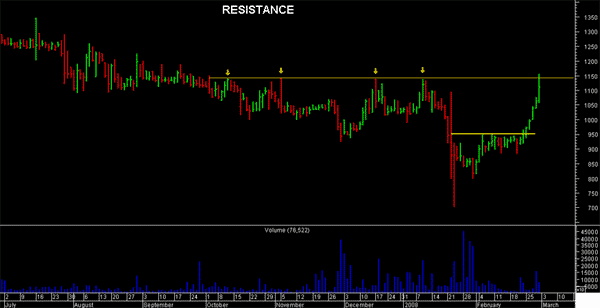Support and Resistance
A support level is a price level at which sufficient demand for any stock appears to stop or hold downtrend temporarily at least and chance of possible reverse from this level. And a resistance zone b the same is a price level at which sufficient supply of any stock is available and stock may turn back from that point.
Think of prices for financial instruments as a result of a head-to-head battle between a bull (the buyer) and a bear (the seller). Bulls push prices higher, and bears lower them. The direction prices actually move shows who wins the battle.
Support is a level at which bulls (i.e., buyers) take control over the prices and prevent them from falling lower.
Resistance, on the other hand, is the point at which sellers (bears) take control of prices and prevent them from rising higher. The price at which a trade takes place is the price at which a bull and bear agree to do business. It represents the consensus of their expectations.
Support levels indicate the price where the most of investors believe that prices will move higher. Resistance levels indicate the price at which the most of investors feel prices will move lower.
But investor expectations change with the time, and they often do so abruptly. The development of support and resistance levels is probably the most noticeable and reoccurring event on price charts. The breaking through support/resistance levels can be triggered by fundamental changes that are above or below investor's expectations (e.g., changes in earnings, management, competition, etc.) or by self-fulfilling prophecy (investors buy as they see prices rise). The cause is not so significant as the effect: new expectations lead to new price levels. There are support/resistance levels, which are more emotional.

One of the most-common and best-known trading strategies is this: "Buy at the support level and sell at the resistance level." The significance of the support level can be understood this way: Imagine that on a given day, for some particular reason (or by sheer chance) a stock is traded very heavily at a certain price level. Also imagine that many traders remember this price level because they bought or sold the stock at this level. Next, suppose that the stock price first moves up away from this level and, later on, (for some reason or no reason) the stock price trades back again to the earlier level. Traders who previously bought the stock and sold it for a profit would likely buy it again at this level. Those who previously sold the stock at this level and missed the recent run-up would have a chance to buy it back. Such buying activities usually slow down the drop and may reverse the momentum. At least, the stock price may take a rest at this level before moving in a new direction. We can then say that the stock price has hit some "support level," by which we suppose that it most likely will not quickly drop through it. The sensible trading strategy is, of course, to buy the stock near this support level, monitor it closely, and sell it to cut losses if it falls meaningfully lower than the support level. If the support level does prevent the stock price from falling and it starts to bounce back, the trader can make a nice profit that is usually much larger (!) than the amount of loss incurred if the trade turned south and loss had to be Resistance becomes support.
When a resistance level is successfully broken through, that level becomes a support level. Similarly, when a support level is successfully broken through, that level becomes a resistance level.
The reason for it is that a new "generation" of bulls appears, who refused to buy when prices were low. Now they are anxious to buy at any time the prices return to the previous level. Similarly, when prices drop below a support level, that level often becomes a resistance level that prices have a difficult time breaking through. When prices approach the previous support level, investors seek to limit their losses by selling.









